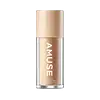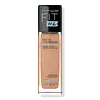What's inside
What's inside
 Key Ingredients
Key Ingredients

 Benefits
Benefits

 Concerns
Concerns

 Ingredients Side-by-side
Ingredients Side-by-side

Water
Skin ConditioningDiisopropyl Sebacate
EmollientTitanium Dioxide
Cosmetic ColorantC12-15 Alkyl Benzoate
AntimicrobialGlycerin
HumectantDiethylamino Hydroxybenzoyl Hexyl Benzoate
UV FilterPropanediol
SolventEthylhexyl Triazone
UV AbsorberCoco-Caprylate/Caprate
EmollientAlcohol Denat.
AntimicrobialNiacinamide
SmoothingDiethylhexyl 2,6-Naphthalate
EmollientPolyhydroxystearic Acid
EmulsifyingBis-Ethylhexyloxyphenol Methoxyphenyl Triazine
Skin Conditioning1,2-Hexanediol
Skin ConditioningButylene Glycol
HumectantPanthenol
Skin ConditioningBetula Platyphylla Japonica Juice
Skin ConditioningPropylene Glycol Dibenzoate
Skin ConditioningCollagen
MoisturisingLeuconostoc/Radish Root Ferment Filtrate
AntimicrobialOryza Sativa Extract
AbsorbentHydrogenated Lecithin
EmulsifyingSodium Hyaluronate
HumectantPentylene Glycol
Skin ConditioningCaprylyl Methicone
Skin ConditioningPolymethylsilsesquioxane
Dicaprylyl Carbonate
EmollientTriethoxycaprylylsilane
Aluminum Hydroxide
EmollientNeopentyl Glycol Diethylhexanoate
EmollientPalmitic Acid
EmollientMicrocrystalline Cellulose
AbsorbentHydroxypropyl Methylcellulose Stearoxy Ether
Methylpropanediol
SolventStearic Acid
CleansingAmmonium Acryloyldimethyltaurate/Vp Copolymer
Ethylhexylglycerin
Skin ConditioningSodium Stearoyl Glutamate
CleansingCellulose Gum
Emulsion StabilisingAdenosine
Skin ConditioningGlyceryl Polymethacrylate
Polyacrylate Crosspolymer-6
Emulsion StabilisingPEG-240/Hdi Copolymer Bis-Decyltetradeceth-20 Ether
StabilisingXanthan Gum
EmulsifyingCitric Acid
BufferingPolyether-1
Biosaccharide Gum-1
HumectantTocopherol
AntioxidantPotassium Laurate
EmulsifyingPolyglyceryl-10 Stearate
Skin ConditioningSodium Ascorbyl Phosphate
AntioxidantAscorbic Acid
AntioxidantTocopheryl Acetate
AntioxidantDimethylsilanol Hyaluronate
HumectantRetinyl Palmitate
Skin ConditioningBiotin
AntiseborrhoeicCyanocobalamin
Skin ConditioningSodium Acetylated Hyaluronate
HumectantSodium Hyaluronate Dimethylsilanol
HumectantSodium Hyaluronate Crosspolymer
HumectantThiamine Hcl
MaskingPotassium Hyaluronate
Skin ConditioningFolic Acid
Skin ConditioningPyridoxine
Skin ConditioningHydroxypropyltrimonium Hyaluronate
Hydrolyzed Sodium Hyaluronate
Skin ConditioningHydrolyzed Hyaluronic Acid
HumectantHyaluronic Acid
HumectantParfum
MaskingCI 77492
Cosmetic ColorantCI 77491
Cosmetic ColorantCI 77499
Cosmetic ColorantWater, Diisopropyl Sebacate, Titanium Dioxide, C12-15 Alkyl Benzoate, Glycerin, Diethylamino Hydroxybenzoyl Hexyl Benzoate, Propanediol, Ethylhexyl Triazone, Coco-Caprylate/Caprate, Alcohol Denat., Niacinamide, Diethylhexyl 2,6-Naphthalate, Polyhydroxystearic Acid, Bis-Ethylhexyloxyphenol Methoxyphenyl Triazine, 1,2-Hexanediol, Butylene Glycol, Panthenol, Betula Platyphylla Japonica Juice, Propylene Glycol Dibenzoate, Collagen, Leuconostoc/Radish Root Ferment Filtrate, Oryza Sativa Extract, Hydrogenated Lecithin, Sodium Hyaluronate, Pentylene Glycol, Caprylyl Methicone, Polymethylsilsesquioxane, Dicaprylyl Carbonate, Triethoxycaprylylsilane, Aluminum Hydroxide, Neopentyl Glycol Diethylhexanoate, Palmitic Acid, Microcrystalline Cellulose, Hydroxypropyl Methylcellulose Stearoxy Ether, Methylpropanediol, Stearic Acid, Ammonium Acryloyldimethyltaurate/Vp Copolymer, Ethylhexylglycerin, Sodium Stearoyl Glutamate, Cellulose Gum, Adenosine, Glyceryl Polymethacrylate, Polyacrylate Crosspolymer-6, PEG-240/Hdi Copolymer Bis-Decyltetradeceth-20 Ether, Xanthan Gum, Citric Acid, Polyether-1, Biosaccharide Gum-1, Tocopherol, Potassium Laurate, Polyglyceryl-10 Stearate, Sodium Ascorbyl Phosphate, Ascorbic Acid, Tocopheryl Acetate, Dimethylsilanol Hyaluronate, Retinyl Palmitate, Biotin, Cyanocobalamin, Sodium Acetylated Hyaluronate, Sodium Hyaluronate Dimethylsilanol, Sodium Hyaluronate Crosspolymer, Thiamine Hcl, Potassium Hyaluronate, Folic Acid, Pyridoxine, Hydroxypropyltrimonium Hyaluronate, Hydrolyzed Sodium Hyaluronate, Hydrolyzed Hyaluronic Acid, Hyaluronic Acid, Parfum, CI 77492, CI 77491, CI 77499
Water
Skin ConditioningCyclohexasiloxane
EmollientNylon-12
Isododecane
EmollientAlcohol Denat.
AntimicrobialCyclopentasiloxane
EmollientPEG-10 Dimethicone
Skin ConditioningCetyl PEG/PPG-10/1 Dimethicone
EmulsifyingPEG-20
HumectantPolyglyceryl-4 Isostearate
EmulsifyingDisteardimonium Hectorite
StabilisingPhenoxyethanol
PreservativeMagnesium Sulfate
Disodium Stearoyl Glutamate
CleansingHdi/Trimethylol Hexyllactone Crosspolymer
Titanium Dioxide
Cosmetic ColorantMethylparaben
PreservativeAcrylates Copolymer
Tocopherol
AntioxidantButylparaben
MaskingAluminum Hydroxide
EmollientAlumina
AbrasiveSilica
AbrasiveGlycerin
HumectantCI 77891
Cosmetic ColorantCI 77491
Cosmetic ColorantCI 77492
Cosmetic ColorantCI 77499
Cosmetic ColorantCeramide AP
Skin ConditioningWater, Cyclohexasiloxane, Nylon-12, Isododecane, Alcohol Denat., Cyclopentasiloxane, PEG-10 Dimethicone, Cetyl PEG/PPG-10/1 Dimethicone, PEG-20, Polyglyceryl-4 Isostearate, Disteardimonium Hectorite, Phenoxyethanol, Magnesium Sulfate, Disodium Stearoyl Glutamate, Hdi/Trimethylol Hexyllactone Crosspolymer, Titanium Dioxide, Methylparaben, Acrylates Copolymer, Tocopherol, Butylparaben, Aluminum Hydroxide, Alumina, Silica, Glycerin, CI 77891, CI 77491, CI 77492, CI 77499, Ceramide AP
 Reviews
Reviews

Ingredients Explained
These ingredients are found in both products.
Ingredients higher up in an ingredient list are typically present in a larger amount.
Alcohol Denat. is an alcohol with a denaturant property. It is created by mixing ethanol with other additives.
This ingredient gets a bad rep because it is irritating and drying - mostly due to its astringent property. Astringents draw out natural oils in tissue, constricting pores and leaving your skin dried out.
However, alcohol denat. is not all that bad.
Due to its low molecular weight, alcohol denat. tends to evaporate quickly. One study on pig skin found half of applied alcohol evaporated in 10 seconds and less than 3% stayed on skin.
This also helps other ingredients become better absorbed upon application.
Studies are conflicted about whether this ingredient causes skin dehydration. One study from 2005 found adding emollients to propanol-based sanitizer decreased skin dryness and irritation. Another study found irritation only occurs if your skin is already damaged.
Small amounts of alcohol are generally tolerated by oily skin or people who live in humid environments.
The rule of thumb is if this alcohol is near the end of an ingredients list, it will probably not affect your skin much.
Also...
This ingredient has antimicrobial and solvent properties.
The antimicrobial property helps preserve products and increase their shelf life. As a solvent, it helps dissolve other ingredients.
Other types of astringent alcohols include:
Learn more about Alcohol Denat.Aluminum Hydroxide is a form of aluminum. It can be naturally found in nature as the mineral gibbsite. In cosmetics, Aluminum Hydroxide is used as a colorant, pH adjuster, and absorbent.
As a colorant, Aluminum Hydroxide may add opacity, or reduce the transparency. Aluminum hydroxide is contains both basic and acidic properties.
According to manufacturers, this ingredient is an emollient and humectant. This means it helps hydrate the skin.
In medicine, this ingredient is used to help relieve heartburn and help heal ulcers.
There is currently no credible scientific evidence linking aluminum hydroxide in cosmetics to increased cancer risk.
Major health organizations allow the use of aluminum hydroxide in personal care products and have not flagged it as a carcinogenic risk at typical usage levels.
Learn more about Aluminum HydroxideCi 77491 is also hydrated iron III oxide. It's sole purpose is to give a red/pink hue to products.
Iron III oxides are classified as inorganic chemicals for coloring.
Synthetically created Ci 77491 is considered safer than those naturally found. This is because the synthetically created version may contain less impurities. Iron oxides are generally non-toxic and non-allergenic.
Learn more about CI 77491Ci 77492 is also hydrated iron III oxide. It's sole purpose is to give a yellow hue to products.
Iron III oxides are classified as inorganic chemicals for coloring.
Synthetically created Ci 77492 is considered safer than those naturally found. This is because the synthetically created version may contain less impurities. Iron oxides are generally non-toxic and non-allergenic.
Learn more about CI 77492Ci 77499 is also hydrated iron III oxide. It is created from mixing red and black iron oxides. This helps give shades of darkness to a product.
Iron III oxides are classified as inorganic chemicals for coloring.
Glycerin is already naturally found in your skin. It helps moisturize and protect your skin.
A study from 2016 found glycerin to be more effective as a humectant than AHAs and hyaluronic acid.
As a humectant, it helps the skin stay hydrated by pulling moisture to your skin. The low molecular weight of glycerin allows it to pull moisture into the deeper layers of your skin.
Hydrated skin improves your skin barrier; Your skin barrier helps protect against irritants and bacteria.
Glycerin has also been found to have antimicrobial and antiviral properties. Due to these properties, glycerin is often used in wound and burn treatments.
In cosmetics, glycerin is usually derived from plants such as soybean or palm. However, it can also be sourced from animals, such as tallow or animal fat.
This ingredient is organic, colorless, odorless, and non-toxic.
Glycerin is the name for this ingredient in American English. British English uses Glycerol/Glycerine.
Learn more about GlycerinTitanium dioxide is a mineral UV filter widely used in sunscreens and cosmetics.
It is one of only two UV filters officially classified as “mineral” by regulatory agencies, the other being zinc oxide.
Titanium dioxide provides broad-spectrum protection mostly in the UVB and UVAII range, with some protection in the UVAI range.
While its UVA protection isn’t as strong as zinc oxide’s, the difference is minor.
A common myth is that mineral UV filters reflect UV light. However, modern research shows titanium dioxide absorbs UV radiation like chemical filters (~95% absorption & 5% reflection).
Thanks to its non-irritating nature, titanium dioxide is suitable for sensitive, acne-prone, or redness-prone skin. It is unlikely to cause "eye sting" like other sunscreen ingredients.
A major drawback of this ingredient is its white cast and thick texture. This is why mineral sunscreens often leave a white cast and are less cosmetically elegant than chemical/hybrid sunscreens.
To improve white cast and spreadability, micronized or nano-sized titanium dioxide is often used.
There are ongoing concerns surrounding nano-titanium oxide's impact on marine ecosystems.
There is no conclusive evidence that any form of titanium oxide (or any other sunscreen ingredients) will cause harm to marine ecosystems or coral reefs. The science is still developing but many consumers are keeping a close eye on this issue.
Please note, many destinations have reef-safety sunscreen rules. For instance, the U.S. Virgin Islands advises all visitors to use non-nano mineral sunscreens.
Nano mineral sunscreens once raised safety concerns about absorption into skin.
Extensive research has shown that they do not penetrate healthy or damaged skin; they remain safely on the surface and the top layer of dead skin (stratum corneum).
You'll likely find titanium dioxide bundled with alumina, silica, or dimethicone. These ingredients help make titanium dioxide highly photostable; this prevents it from interacting with other formula components under UV light.
Learn more about Titanium DioxideTocopherol (also known as Vitamin E) is a common antioxidant used to help protect the skin from free-radicals and strengthen the skin barrier. It's also fat soluble - this means our skin is great at absorbing it.
Vitamin E also helps keep your natural skin lipids healthy. Your lipid skin barrier naturally consists of lipids, ceramides, and fatty acids. Vitamin E offers extra protection for your skin’s lipid barrier, keeping your skin healthy and nourished.
Another benefit is a bit of UV protection. Vitamin E helps reduce the damage caused by UVB rays. (It should not replace your sunscreen). Combining it with Vitamin C can decrease sunburned cells and hyperpigmentation after UV exposure.
You might have noticed Vitamin E + C often paired together. This is because it is great at stabilizing Vitamin C. Using the two together helps increase the effectiveness of both ingredients.
There are often claims that Vitamin E can reduce/prevent scarring, but these claims haven't been confirmed by scientific research.
Learn more about TocopherolWater. It's the most common cosmetic ingredient of all. You'll usually see it at the top of ingredient lists, meaning that it makes up the largest part of the product.
So why is it so popular? Water most often acts as a solvent - this means that it helps dissolve other ingredients into the formulation.
You'll also recognize water as that liquid we all need to stay alive. If you see this, drink a glass of water. Stay hydrated!
Learn more about Water